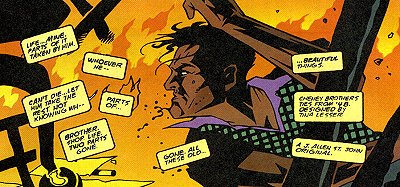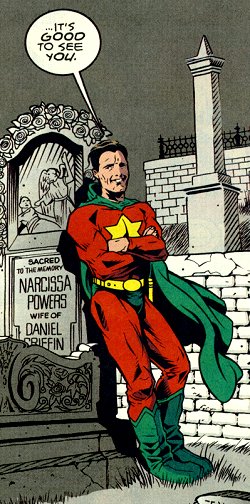Starman

 review of #0-20
review of #0-20
What can I say about this series that hasn’t already been said? Well, I could say that it’s a lot like the original “Porky’s” movie, or that it’s been shown to prevent melanoma in laboratory bats… but the reason no one’s said these things is that they’re utter nonsense. {smile}
 Based on the art alone, I predicted that this would be The Winner among the post-Zero-Hour titles. [In fact, it's the last one still published; Fate ended a couple of months after this review was written.] Harris’ covers and interior pencils were stylish (not be confused with “fashionable” or “trendy”) and well done. Von Grawbadger’s inks qualified for similar praise. And from the beginning, Gregory Wright’s colors have been distinctive and well-chosen.
Based on the art alone, I predicted that this would be The Winner among the post-Zero-Hour titles. [In fact, it's the last one still published; Fate ended a couple of months after this review was written.] Harris’ covers and interior pencils were stylish (not be confused with “fashionable” or “trendy”) and well done. Von Grawbadger’s inks qualified for similar praise. And from the beginning, Gregory Wright’s colors have been distinctive and well-chosen.
But remarkably, the art has improved since the first few issues. The change seems (to my inexpert eye) to come largely from the inking and coloring, which have both gotten more detailed and three-dimensional. (See the attached examples, the one above from #0, the one to the left from #20.)
 However, the real… er… star of this series is Robinson’s writing. While it’s been criticised (with some justification) for being pretentious and self-indulgent (e.g. the gangsters-debating-Sondheim-musicals scene in #14, taking five issues to tell the same one-day story from different characters’ perspectives), and for mucking about with established characterisation and history (e.g. casting doubt on the integrity of JSA members, characters being too young or too not-dead) it’s refreshing to see someone taking a different angle on superhero writing.
However, the real… er… star of this series is Robinson’s writing. While it’s been criticised (with some justification) for being pretentious and self-indulgent (e.g. the gangsters-debating-Sondheim-musicals scene in #14, taking five issues to tell the same one-day story from different characters’ perspectives), and for mucking about with established characterisation and history (e.g. casting doubt on the integrity of JSA members, characters being too young or too not-dead) it’s refreshing to see someone taking a different angle on superhero writing.
Robison’s real strength in Starman is in creating a sense of setting, using DC’s long history to his advantage, rather than letting it be just an albatross to carry around. Opal City itself is a character in the book, and rather than killing off the original Starman (and all the other characters who’ve maintained the trademark), Robinson has kept them around and used them… even if he has to fudge history a little to make it work.
He’s also doing a good job developing the character of Jack Knight. Jack’s background, relationship to his family, real-world interests, and so on have fleshed this character out far more than the fairly superficial characterisation of, say, the new Green Lantern (he’s an artist, so he does some really kewl visual things with his power ring). You get inside Jack’s head, and get an idea of why he’s letting people call him “Starman”, and how he’ll handle this strange role.
 The initial story arc, “Sins of the Father” deals with how Jack Knight reluctantly took over the family “business” after his father retires and his older brother is killed in the line of duty. (It’s been collected into a TPB.) This is the story that created the buzz about Robinson and Starman, and rightly so.
The initial story arc, “Sins of the Father” deals with how Jack Knight reluctantly took over the family “business” after his father retires and his older brother is killed in the line of duty. (It’s been collected into a TPB.) This is the story that created the buzz about Robinson and Starman, and rightly so.
In addition to these story arcs (which are now a staple of superhero comics), Robinson has a few gimmicks of his own. One is the annual “Talking With David” issues, in which Jack meets with his murdered brother. Everything is colored in shades of grey… except for David’s brightly-colored Starman costume (which Jack refuses to wear). Another is the “Times Past” story, which Robinson has used to tell about the 19th century exploits of the mysterious villain The Shade in #6, and one of the final missions of several Justice Society heroes (including the original Starman) in #11. Finally, Robinson sometimes uses the letter-column pages for text excerpts from Shade’s journal. (Robinson also welcomes letters on topics other than comics itself… antique collecting, in particular.)
The most uneven (and most criticised) storyline in the series is “Sins of the Child”, which takes place over a single day, but took five months to tell. Parts were very good (the Underworld Unleashed tie-in featuring Jack’s father, in #13); others were not (the pointlessly violent chapter featuring the blue alien and Solomon Grundy, in #15). And the conclusion (an ironic take on the “arch-nemesis” cliche in superhero comics) was a disappointment. It was a neat experiment that didn’t quite work.
The latest storyline (starting in #20) involves the original Sandman, one of the oldest (and most aged) heroes in the DCU. (It ties in losely with the concurrent storyline in Sandman Mystery Theatre, which features the original Starman in a guest role.) It’s a good read so far, and I recommend checking it out.
